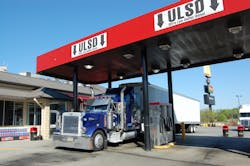For seventh week, diesel prices continue to dip
For the seventh consecutive week, average U.S. diesel prices continue to decline, according to the Energy Information Administration (EIA). This week, diesel prices dropped 1.8 cents to $2.814, compared to last week’s $2.832, EIA said. This week’s price is $1.080 per gallon cheaper compared to the same week last year.
Diesel prices decreased in all but one region this week: Rocky Mountains, up two tenths of a cent to $2.787.
Similar to last week, four regions continue to break the $3 per gallon mark:
-
California, down nine tenths of a cent to $3.133 per gallon;
-
The Central Atlantic, down 3.5 cents to $3.038;
-
The West Coast including California, down 3.2 cents to $3.037;
-
New England, down 3.1 cents to $3.020;
Average U.S. retail pump prices for gasoline increased by 4.1 cents this week to $2.834 per gallon. According to EIA, that is still 80.1 cents cheaper compared to the same week last year.
Gasoline prices increased in four regions this week: the West Coast including California, up 29.2 cents to $3.589; the West Coast without California, up 2 cents to $3.085; the Rocky Mountains, up 8 tenths of a cent to $2.818; and the Gulf Coast, up 6 tenths of a cent to $2.527.
According to EIA’s July Short-Term Energy Outlook, summer gasoline prices are the lowest they’ve been since 2009. EIA said the decline is mainly due to the result of the projected 41% year-over-year decline in the average price of North Sea Brent crude oil.
“Travel and gasoline consumption are expected to be higher this summer compared to levels in 2014,” EIA said. “Motor gasoline consumption is expected to increase by 194,000 barrels per day, up to 2.1% from last summer, reflecting higher disposable income, substantially lower retail motor gasoline prices, and higher employment and consumer confidence.”
About the Author

Cristina Commendatore
Cristina Commendatore is a past FleetOwner editor-in-chief. She wrote for the publication from 2015 to 2023.
